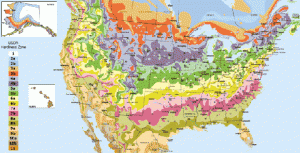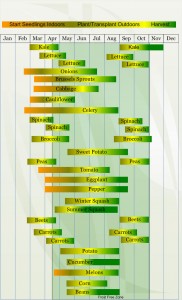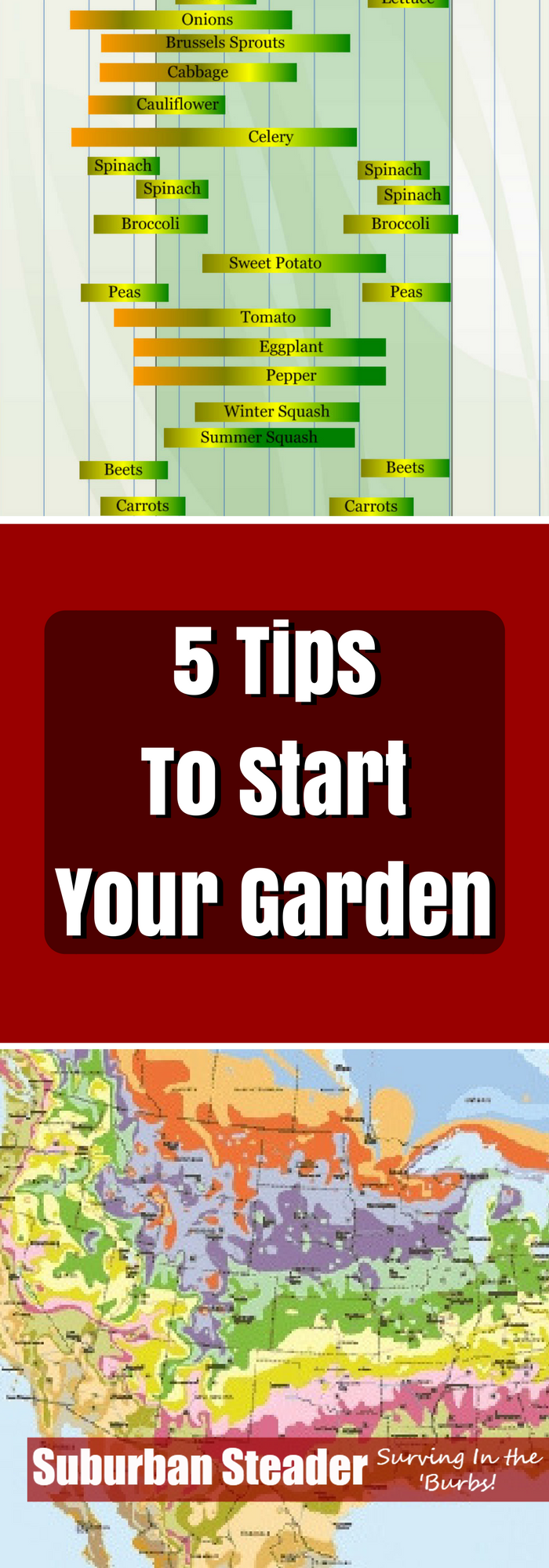5 Tips To Start Your Garden
Suburban homesteading usually involves some kind of food production. While a homestead on multiple acres may allow for row farming and grazing for large animals, suburbanites need to scale back a bit. Rabbits and chickens may be reasonable sources for protein, but your fruit and vegetable production is usually scaled down to the gardening level. While not as abundant as a multi-acre setup, a high quality suburban garden can produce more than enough food to adequately supplement your weekly fruit and vegetable intake. Our 5 Tips To Start Your Garden will help you get there more quickly!
1. Know Your Zone
First, let’s define what we’re talking about when we say ‘zone.’ The United States Department of Agriculture (USDA) has split North America into roughly 11 separate hardiness zones; each about 10oF warmer or colder than its adjacent zones. The higher the zone number, the warmer the area.

Knowing your zone gives you a good idea what crops are available to you. Some crops that grow well in a hearty zone in Michigan (say 5 or 6) will have no chance growing in the heat of mid- to south-Texas (zones 8 or 9). Likewise, plants like citrus that need the super warmth in areas like southern Florida (Zone 10) won’t do well in more temperate climates like Boston (Zone 6). Selecting your crops accordingly can help remove some disappointment in the future.
Finding your zone is rather simple – just click the link below to see what your USDA Hardiness Zone is:
2. Determine Your Space
This step is relatively simple: determine how much space you are going to set aside for growing crops. While you may want to jump over this step with a quick answer, spend a few minutes thinking about it from two perspectives:
- Location – the closer you put your garden to your house, the more you’ll be likely to go into it on a regular basis to maintain it (weeding, harvesting, watering, etc.). With that in mind, make sure you aren’t sacrificing sun exposure for proximity to your house.
- Size – While a huge garden may seem desirable, you also have to maintain it. A larger garden is going to have more work associated with it. Make sure you decided on a size that is both promising to your end production goal and manageable given your other responsibilities.
3. Identify What You Eat
Put very simply: only grow what you’ll eat. What sense is there in growing tomatoes if you can’t stand them? Likewise, you’re less likely to care for the garden if you realize you’re not going to partake in its bounty. Growing what you eat is a simple way of helping to ensure you stay engaged in the gardening experience.
Don’t take this tip to mean you can’t experiment. If you want to throw in a few plants of a fruit or vegetable you have never tried, by all means, do it. Just make sure the majority of your garden is items you intend to eat.
4. Make A Plan
 You don’t need to be a certified Project Manager to plan out a garden, but a little forethought is useful. The last thing you want to do is plant your vegetables so they all come in at once or, worse, plant them at the wrong time. To help you plan out your planting schedule, I suggest you visit the following links:
You don’t need to be a certified Project Manager to plan out a garden, but a little forethought is useful. The last thing you want to do is plant your vegetables so they all come in at once or, worse, plant them at the wrong time. To help you plan out your planting schedule, I suggest you visit the following links:
VeggieHarvest.com Planning Guide
VeggieHarvest.com Planting Zone Calendars
The first link has a great guide which talks more in-depth about a lot of the issues addressed in this post.
Possibly more importantly, the second link allows you to print a copy of the planting calendar that is relevant to your Hardiness Zone.
For instance, here on Long Island, I’m in Zone 7. This graph quickly shows me that I should have started peas, broccoli and cauliflower at the beginning of March (which I did) and should getting them in the ground around April 1st.
I can also use this calendar to plan out the rest of my garden. It’s also a great too when you start to think about doing a spring/summer/fall approach to your garden for extended production.
5. Be Flexible, Adapt and Document
Gardening is not an exact science and is very dependent on a variety of inputs including sun, rain, freeze, heat, seed quality, animals, bugs, soil…. The list goes on and on. What you have to do is be willing to change and let you garden take you through the process. If you pay attention, your plants will tell you what they need.
The other trick is to document yourself. Keep track of what you plant, when you plant it and where it was planted. After a few cycles, you’ll start to see patterns emerge. For instance, I know that if I plant broccoli after the last freeze, I tend to get a worse crop than I do if it’s planted before that time. I also know that certain seeds work better for me.
Keeping an open mind and quality records allow you to build a better garden year after year.
5 Tips To Start Your Garden – Wrap-Up
So there you have it – 5 Tips To Start Your Garden! All these simple tips are easy to accomplish and can be done within a day. That means you should be able to get a garden planned and ready to roll this weekend.
Above all, remember that running a garden should be a rewarding and relaxing experience. It should not be taxing or considered ‘work.’ Yes, you’re going to have to put some effort in to make it work, but you’ll get much more out of it than you put into it if you follow these five steps up front.
Did we miss anything? Do you disagree with anything we wrote? Let us know in the comments below or on our Facebook page!